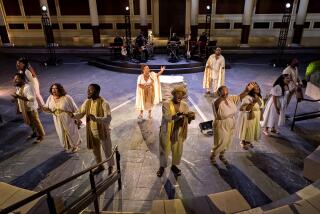Startling Images From an Indian Repertory
- Share via
From its devotional humming overture in the dark to its apotheosis of golden Buddhas some 90 minutes later, “Uttar-Priyadarshi” (The Final Beatitude) offers a somber, imaginative theatrical meditation on the power of religion to stop and even reverse the impulse toward violence in human nature.
Composed, designed and directed by Ratan Thiyam for his 27-member Chorus Repertory Theatre of Manipur in northeastern India, the production filled UCLA’s Royce Hall on Thursday with one startling image after another, some of them deliberately anachronistic. Start with the emperor Ashoka from the 2nd century BC leading his army from the top of an elephant--but later invading a realm of evil in which the guillotine and electric chair are prime instruments of execution.
Crimson banners form rivers of blood in another scene--a setting in which the widows of war wail their loss, dressed like wraiths in long hooded robes of white gauze. And always Thiyam heightens the intensity of his imagery by artful layers of sight and sound: dramatic gesture in front of large-scale dances, for instance, or gutsy chant over expansive song.
With his contemporary, utilitarian setting but alternately traditional and hallucinatory costumes, Thiyam boldly borrows from a number of epochs and idioms to create forceful stagecraft. Group movement is almost always choreographed here and the expressive vocalism of the piece takes it into the category of opera.
But Thiyam keeps his thematic priorities paramount and, except for the splashy but arguably overextended devil’s divertissement in scenes 3 through 5, it’s impossible to miss his strongly physicalized contrasts between prime Buddhist teachings and the vile battleground that headstrong humans make of this world.
Based on a short poem by Ajneya, “Uttar-Priyadarshi” somehow fails to make credible to a foreign audience the troubled Ashoka’s empowerment of Ghor, a creature representing wanton destruction. Nor does the authoritative but essentially passive figure of Bhikshu--the ultimately triumphant mendicant monk--persuasively outweigh all the colorful, dynamic fiends sent to annihilate him.
*
These moments and plot points must be taken on faith--though, of course, audiences intimate with the Meitei language and cultural traditions of Manipur may disagree. What’s more important, however, is the moral force of the work as a whole and the wide-ranging expertise of a company entering its 25th season but never before seen in this country.
The leading roles receive intense performances from R. K. Bhogen (Ashoka), Ibomcha Sorok (Ghor) and Robindro (Bhikshu), but it’s the fervor of the ensemble that supports their declamatory style and keeps the piece at epic scale.
Indeed, the fusion of ancient and modern, exotic and mundane that Thiyam aims for may be most brilliantly realized not in anything he assigns his principals but in his corps of insanely gleeful, faceless women-demons. Sporting long white hair and matching whisks, they dance restlessly in one passage and elsewhere take snapshots of one another holding a newly severed head.
It may be our tragedy that we understand decapitation as a photo op better than the potential for Buddhist enlightenment within ourselves. However Thiyam’s luminous theatrical fable provides a compassionate vision of our capacity for growth.
More to Read
The biggest entertainment stories
Get our big stories about Hollywood, film, television, music, arts, culture and more right in your inbox as soon as they publish.
You may occasionally receive promotional content from the Los Angeles Times.










